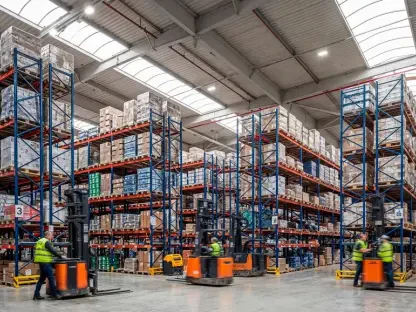Amazon Logistics is set to redefine the landscape of parcel delivery in the United States, aiming to surpass the U.S. Postal Service in terms of domestic parcel volume within a few short years. The shipping giant’s increasingly ambitious target highlights not just the company’s rapid growth trajectory but also a significant shift in the competitive dynamics of the shipping industry. By 2028, Amazon is projected to ship an impressive 8.4 billion parcels domestically, surpassing USPS’s expected figure of 8.3 billion parcels, according to the Pitney Bowes’ 2024 Parcel Shipping Index. With its current standing as the second-largest player in terms of market share, Amazon has already outpaced FedEx and UPS, carving a niche by increasing its delivery capacity and leveraging its robust logistics network. This development is closely tied to Amazon’s strategic maneuvers to mitigate dependency on third-party delivery services, especially in light of UPS’s plan to halve their delivery volume for Amazon by the upcoming year, focusing on more profitable sectors.
Strategies Driving Amazon’s Expansion
Amazon’s aggressive expansion strategy is fueled by the need to diversify and control its supply chain, ensuring reliability and sustainability of delivery services across the nation. The decision to invest heavily in its delivery infrastructure stems from a broader vision to not only secure its core business but also to challenge the existing industry giants such as FedEx and UPS directly. This strategic pivot underscores Amazon’s vision to innovate delivery methodologies and introduce competitive shipping solutions that cater to changing consumer expectations. Amidst this seismic shift, alternative delivery providers are also surfacing, leveraging modern technology and innovative logistics solutions to stake their claim in the industry. In this highly competitive environment, traditional carriers face mounting pressure as these emerging players demonstrate notable year-over-year growth, reshaping market dynamics. Pricing pressures have led to a modest decrease in revenue per parcel, indicating the complex interplay between volume challenges and financial performance in the parcel market.
USPS’s Response and Market Competition
USPS is actively seeking avenues to regain its footing in the rapidly evolving parcel delivery arena, particularly as Amazon Logistics continues to amplify its reach. Responding to this shift, USPS has escalated its efforts to secure more direct customer contracts through its Ground Advantage service, aiming to increase its market share and maintain relevance in this shifting landscape. The strategy highlights USPS’s commitment to preserving its traditional market dominance amidst fierce competition from Amazon and others. In 2024, USPS recorded 6.9 billion parcels, marking a significant turnaround as the agency experienced its first year-over-year volume growth since 2020. However, this resurgence faces challenges, not only from established players but also from alternative delivery providers, who collectively shipped 780 million parcels in the same year, boasting a remarkable growth rate of 22.6%. These dynamics illustrate the evolving nature of parcel delivery competition and the critical role innovation plays in shaping future strategies.
Future Outlook and Industry Implications
Amazon Logistics is poised to radically transform parcel delivery across the United States, with ambitions to exceed the U.S. Postal Service’s domestic parcel volume in a few short years. This ambition underlines not only Amazon’s speedy expansion but also signifies a major shift in shipping industry competition. By 2028, projections from the Pitney Bowes’ 2024 Parcel Shipping Index anticipate Amazon delivering an impressive 8.4 billion parcels domestically, edging out USPS’s anticipated 8.3 billion parcels. As the second-largest market share holder, Amazon has already surpassed FedEx and UPS by ramping up its delivery capacity and maximizing its extensive logistics network. This evolution is intricately linked to Amazon’s strategy to reduce reliance on third-party delivery services. Particularly relevant is UPS’s plan to cut its delivery volume for Amazon by the next year, focusing on more lucrative sectors. Amazon’s initiatives place it in a strong position to become the market leader in domestic parcel delivery.









